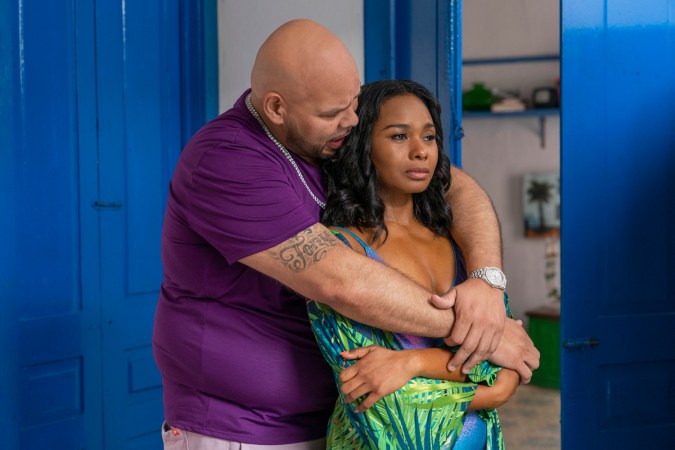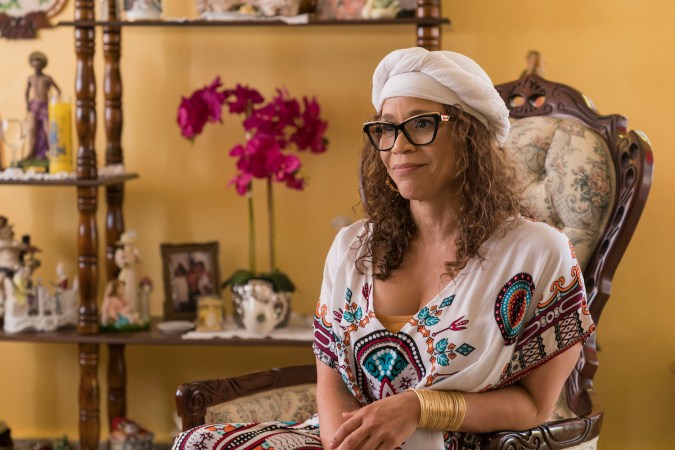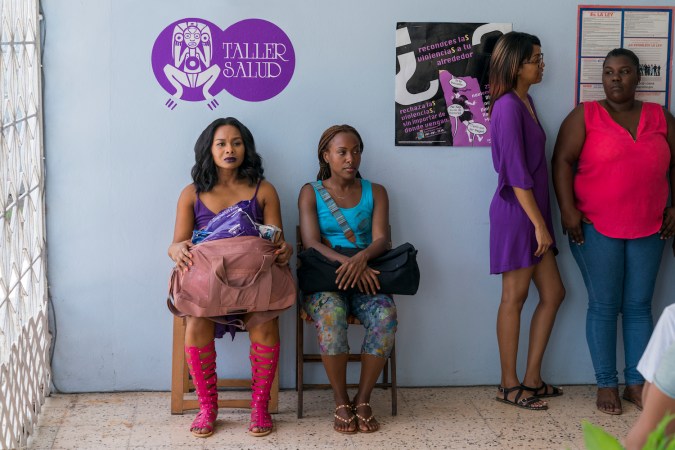It didn’t come out of nowhere that Spike Lee asked Lemon Andersen to write a bottle episode about Puerto Rico for the second season of his acclaimed Netflix series She’s Gotta Have It. Nuyorican Andersen had been a story editor on season one (one of many gigs in 15 years of working with Lee), and two of the show’s characters, Mars Blackmon, played by Anthony Ramos, and his sister, the Yoruba practicing LuLu (Santana Caress Benitez) are Nuyorican.
Andersen assumed he’d be filtering the episode through a Nuyorican POV. But Lee surprised him — and the rest of the cast, Fat Joe included — by writing “Puerto Rico” on the writers’ room board. It was understood then that the episode, #OhJudoKnow?, would take place on the island. “That changed the whole dynamic for me, because I had to now think about shooting on the island,” Andersen says. “I had an open gate to go back and forth from the writers’ room to the island, finding producers, and chasing the imagination with Spike.”
Having raised funds for Puerto Rico post-Hurricane Maria, Spike Lee, he says, was wholly invested in the episode, as was Andersen. “My mother and grandmother are buried there, in Fajardo,” he says. Before writing the episode, his most recent trip to Puerto Rico was in 2017, a week post-Maria. Andersen understood clearly how dire the situation had become: “When you see people, your own people, drinking water out of the floor, trying to push pipes into the sides of the roads so there can be some clean water coming down from the hills — this isn’t what we’re supposed to do, right? We’re not supposed to colonize an island then allow these people to suffer.”
In his beginnings as a poet and spoken word artist, Andersen followed the traditions of Nuyorican poets, and as far back as his late teens, during his time at Brooklyn’s El Puente Community Center, he’s been committed to activism.


“There’s so many different historical narratives when it comes to our island, and getting it right — everything had to be so subtle. I tried to approach it like I was the island’s son.”
“I lost a lot of sleep because of this one. This one was different,” he says. “It wasn’t because of the hard work; it was because the ancestors were keeping me up at night.”
Andersen is familiar with the Yoruba religion but doesn’t practice himself — still, the impactful scene where Nola Darling (played by DeWanda Wise) sees Oshun (or a vision of the deity) was influenced by a spiritual adviser of his own community. It symbolized a connection, too: “This is where someone black from America comes in and sees how African we are,” Andersen says.
It didn’t make sense to bring a lot of characters on the trip, he notes. But the group gathered — Winny (Fat Joe), Shemekka (Chyna Lane), Nola, and Mars — for a trip that would inspire them all, in particular Nola as an artist, offered the blend of perspectives Andersen wanted. “[The episode was] not going to be real unless a visitor comes. Because we know what a Puerto Rican looks like there, but we need to know what a visitor looks like when they finally see all of this,” he says.

Aiming to pack in as much authentic history, culture, tradition, and context related to Puerto Rico’s current situation, Andersen’s episode was originally 90 minutes long — and Lee gave the green light to film everything, he adds. Of course, editing down to fit into the series’ typical episode length (just under 40 minutes) was necessary. But the elements that remained were important, well-considered choices: Emblems of Puerto Rican resistance and independence are included throughout, like the locally preferred version of the Puerto Rican flag — celestial blue, rather than the U.S.-matching navy — that nods to the original, and the bike riding scene that features the revolutionary national anthem, “La Borinqueña” by Lola Rodríguez de Tío, which was later lyrically depoliticized post-U.S. takeover.

“There’s so many different historical narratives when it comes to our island, and getting it right — everything had to be so subtle,” Andersen says. “I tried not to be overwhelming. I tried to approach it like I was the island’s son. It was this weird relationship I had throughout the whole process, of trying to make this connection constantly, and then write it and continue the storyline of these characters … Keeping an honest approach to what was really going on in PR through characters on the island as well. It was a lot.”
Adding to that lived in feeling, is the fact that some scenes were improvised. Lee and Andersen kept Rosie Perez’s guest starring role as Doña Lucy Christina, mother to Mars and LuLu, a secret for months. “Spike is a big fan of Anthony’s, and there’s a lot of potential there for that young man. We kind of wanted to do this thing where it was a sincere introduction to each other, a reintroduction to each other, as a mother and son. Spike knows what he’s doing; he’s been doing this a long time. So we set it all up and we just let them go.”
Another organic moment is found in the bomba y plena circle at the edges of the River Loíza, on the east coast of the main island. “We had them giving Nola Darling an African tradition by being there, by the river. That whole scene was very real,” Andersen says. “[DeWanda] felt it. It was all very real to everyone; people were crying on the set.”
Also very real were the donations delivered throughout the episode, including aid for the long-standing feminist organization Taller Salud, which advocates and provides services for the community of Loíza, its women in particular. “The donations are ongoing. We didn’t get up and go,” Andersen says. “We still have a relationship with those organizations and the Maria Fund. We meant business. But that was Spike — he really wanted to do that. We had these conversations about the life-term effort. Not just being in the short term or the long term, but for the life term. When you give to an organization or you give to a community, you have to literally marry that community. You have to be a part of it forever.”

Crew working on the episode was about 80 percent Puerto Rican. “We hired directly from the island,” Andersen explained. They were recruited during eight or nine preproduction trips. “I wanted Spike to see who these people are, right? And he loved them. And the New York crew, I wanted them to see and feel the love that these people have. These people love their jobs. They want to create content. There’s a great crop of talent in Puerto Rico,” he says.
Andersen hopes the episode will draw more compassionate visits to Puerto Rico. “When I was watching everyone raise money again and get all the supplies together [after Maria], I was like, this is not enough. We have to go there. I kept telling people, you have to go to Puerto Rico and be with the people, and hold them and hug them and love them,” he says.
Ending the episode with a speech from Pedro Albizu Campos, an icon of Puerto Rico’s independence movement, seems to wrap up Andersen’s intentions to give insight to the reality of the archipelago’s history, culture, and people — while inviting viewers to take the initiative and learn more on their own.




